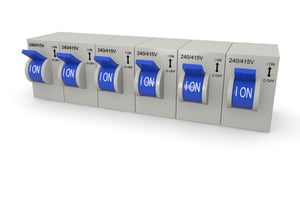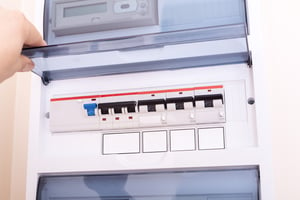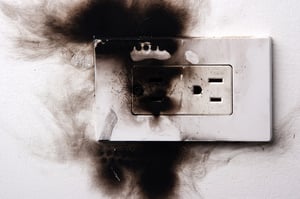 What is a Circuit Breaker?
What is a Circuit Breaker?
A circuit breaker is a mechanical switching device that automatically protects an electrical circuit from damage generated from excess current from an overload. A circuit breaker’s main function is to detect a faulty condition and once that condition is detected the circuit breaker will interrupt the current flow during both normal or abnormal conditions. Depending upon the type of circuit breaker they can be reset automatically or manually. The ability to reset is what separates a circuit breaker from a fuse. A fuse is only able to operate once and then must be replaced. When a circuit breaker detects the fault and interrupts the current flow, it can be reset manually or automatically and resume normal operation.
 There are 5 key components that make up a circuit breaker. The first component is the molded case or frame. The case or frame is what houses, supports, and insulates the unit. Next is the operating mechanism. This component opens and closes the contacts which is basically turning the circuit ON and OFF. When an arc is created by the interruption of the circuit breaker, it will need to be extinguished. That function is carried out by the arc extinguisher. The next component is the contacts, which consist of the movable contact, the movable contact arm, the stationary contact and the stationary conductor. These contacts are what allow the current to flow.
There are 5 key components that make up a circuit breaker. The first component is the molded case or frame. The case or frame is what houses, supports, and insulates the unit. Next is the operating mechanism. This component opens and closes the contacts which is basically turning the circuit ON and OFF. When an arc is created by the interruption of the circuit breaker, it will need to be extinguished. That function is carried out by the arc extinguisher. The next component is the contacts, which consist of the movable contact, the movable contact arm, the stationary contact and the stationary conductor. These contacts are what allow the current to flow.
Last is the trip unit, which is the most important part of the circuit breaker. The trip unit senses the fluctuation in the current flow and trips the operating mechanism.
A circuit breaker operates by allowing electricity to enter the control switch and continue towards the moving contact through the terminal. On its way to the power outlet the electrical current must cross the moving contact. When the electrical current successfully crosses the moving contact, it will reach a stationary contact. The moving and stationary contacts will remain connected if the electrical circuit is operating properly and at safe levels. This allows the electrical circuit to continue to function.
 If the electrical current isn’t functioning properly and unsafe levels of electricity are detected, the catch will be triggered causing the connection between the moving and stationary contacts to break. A faulty electrical current is detected through the electromagnet or bi-metallic sensor sensing the electromagnetic field flowing through the circuit breakers switches. The sensor will bend once the flow begins to reach unsafe levels. This bend will then break the connection with the catch, in turn offsetting any unsafe electricity and causing the switch to flip off.
If the electrical current isn’t functioning properly and unsafe levels of electricity are detected, the catch will be triggered causing the connection between the moving and stationary contacts to break. A faulty electrical current is detected through the electromagnet or bi-metallic sensor sensing the electromagnetic field flowing through the circuit breakers switches. The sensor will bend once the flow begins to reach unsafe levels. This bend will then break the connection with the catch, in turn offsetting any unsafe electricity and causing the switch to flip off.
Circuit breakers are categorized based on a variety of features including intended voltage applications, design characteristics, type of installation, and arc extinction medium used. The most common mediums for extinction of electric arcs are air, oil, gas, or vacuum. Four different types of circuit breakers based on these mediums are air magnetic circuit breakers, air blast circuit breakers, oil circuit breakers and vacuum circuit breakers.
Without circuit breakers, an electrical circuit can try to push more current through which could potentially cause a multitude of problems. A fire is an example of a problem that could occur without circuit breakers in place. Thankfully circuit breakers sense excess current and shut down the electrical circuit before a problem occurs, providing safety and functionality.
To learn more about Radwell
For a behind the scenes look at Radwell


